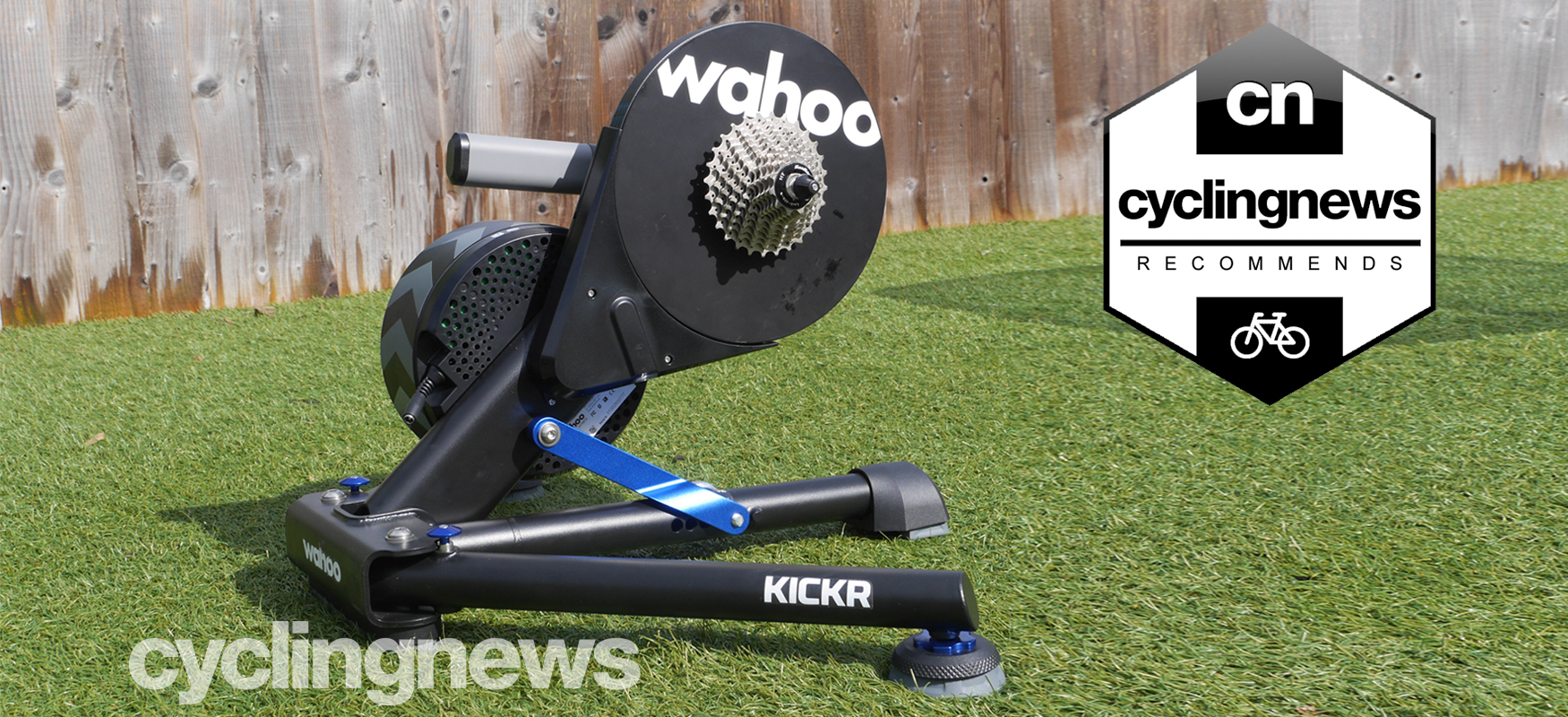Cyclingnews Verdict
A truly top-end turbo trainer that's accurate, consistent and easy to use, making it a brilliant upgrade to anyone's indoor cycling setup, especially if you can find it discounted
Pros
- +
Industry-leading connectivity
- +
Quiet
- +
Road feel
- +
Automatic calibration
- +
Simple setup
Cons
- -
Price
- -
Axis Feet aren't very effective
You can trust Cyclingnews
This iteration of the Wahoo Kickr, version number five, was launched in August 2020. It was a perfectly timed launch that fell during the COVID-19 pandemic, just two weeks after the first-ever Virtual Tour de France. As with every iteration of the Kickr to date and since, it represented evolution rather than revolution, taking the Kickr V4 and adding a handful of carefully considered updates.
These included a new zero-calibration algorithm, an increase in data accuracy from a variance of two per cent to just one, a new wired port and Axis feet.
Despite the upgrades, the price stayed the same, at £999.99 / $1,199.99 / AU$1,799.95. At that price, it goes head to head with the best smart trainers in the segment, but if the previous model was anything to go by, the Wahoo Kickr V5 would be a popular and worthwhile choice for anyone looking to pedal their way through a pandemic.
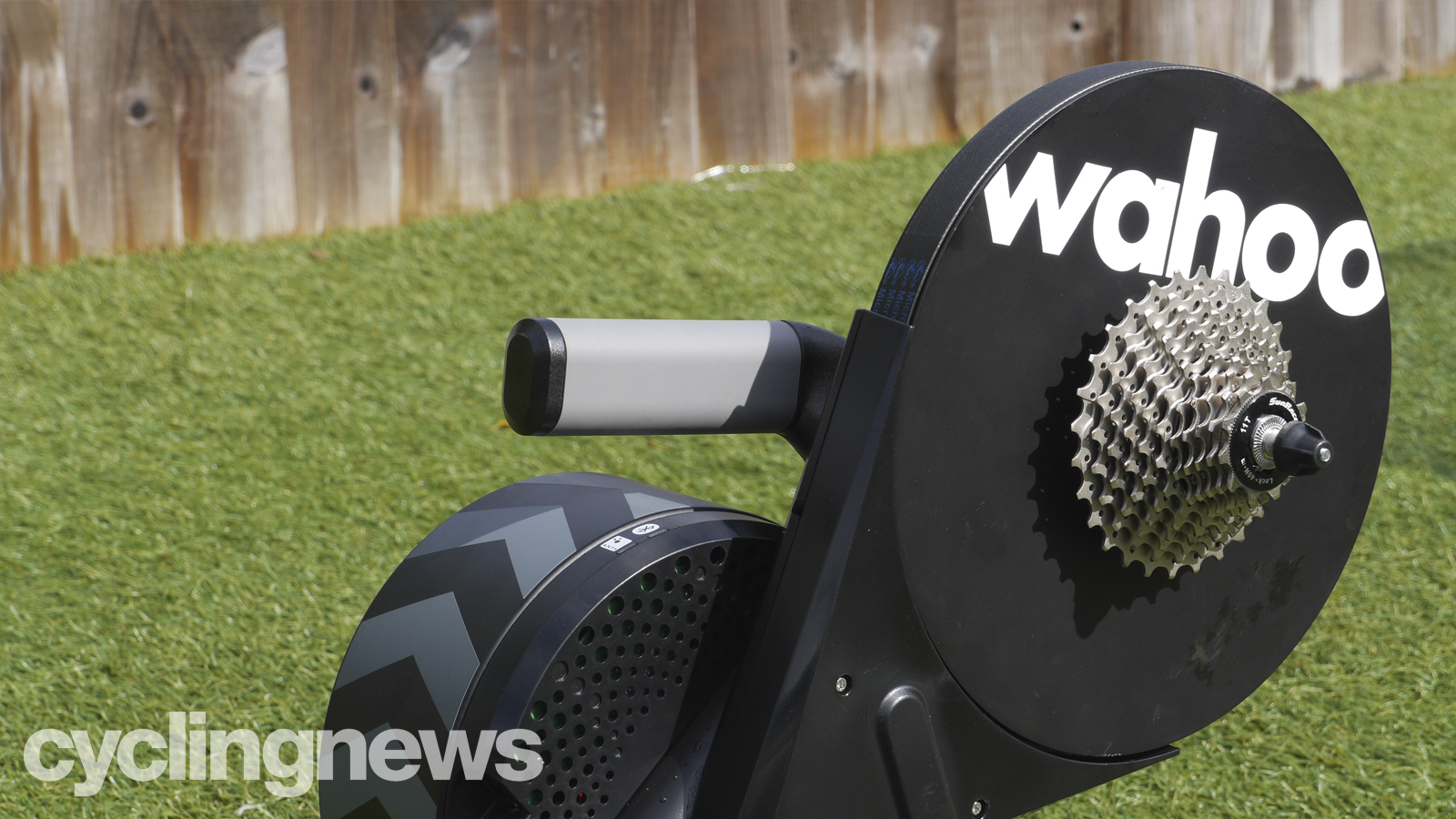
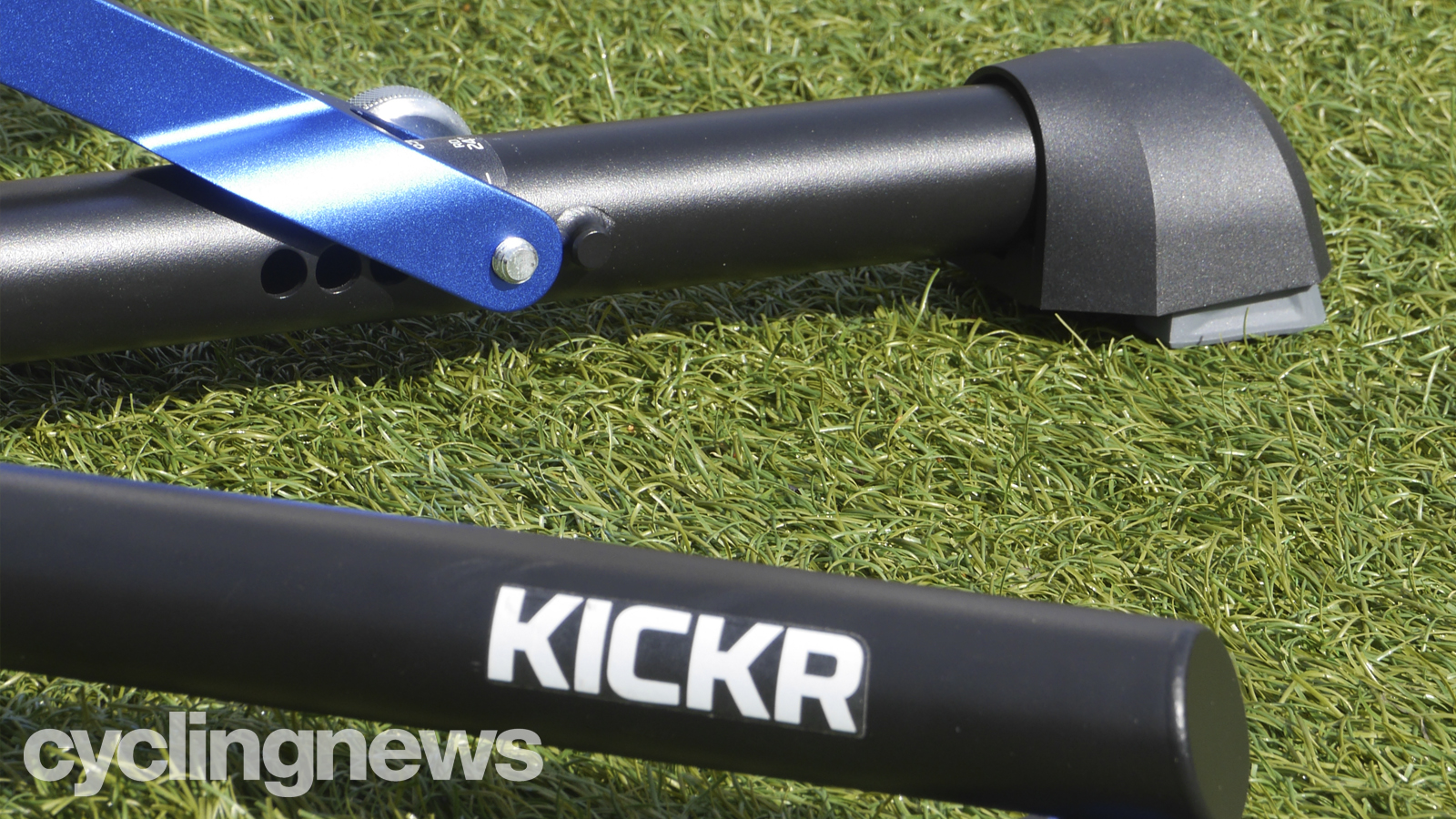
Design and aesthetics
Aesthetically, the Kickr V5 2020 is hard to tell apart from its forebear, and even harder to tell apart from its 2022 replacement. They all share the same folding legs and height adjustment built into the central leg, as well as the same exposed 7.3kg/16lb flywheel, rubber-clad carry handle, and Wahoo logo placement.
The power cable still connects to an external short 'female' cable at the rear, and the bike mounts into place using the same choice of adaptors, making it compatible with all modern standards of quick release and thru axle (apart from boost). The same Sunrace 11-speed Shimano/SRAM cassette comes fitted, and SRAM 12-speed drivers are sold separately.
The two telltale physical differences from the V4 are the new Axis feet and the wired port for an RJ25 cable. Whereas the newer V6 gets a WiFi status light.
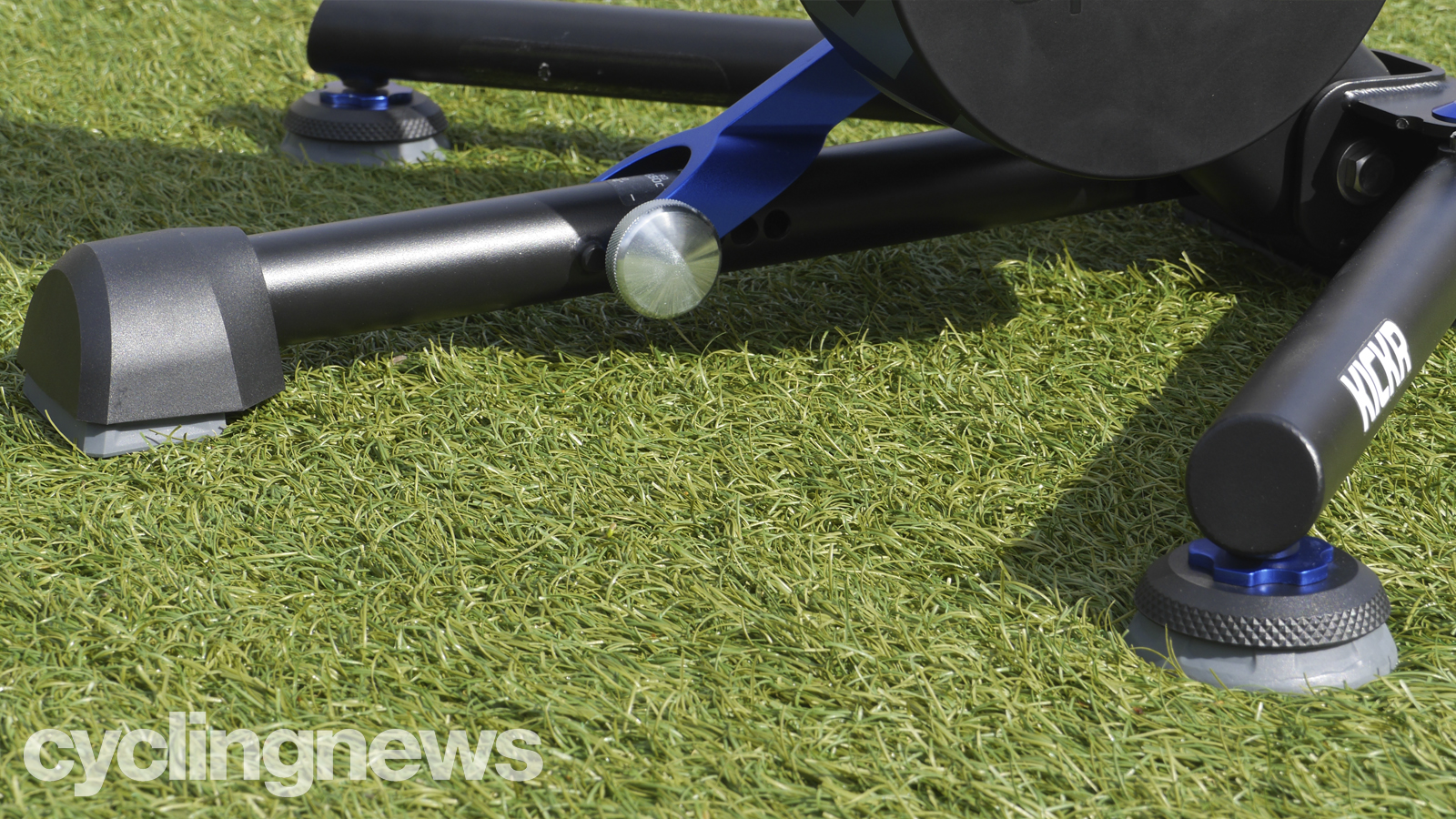
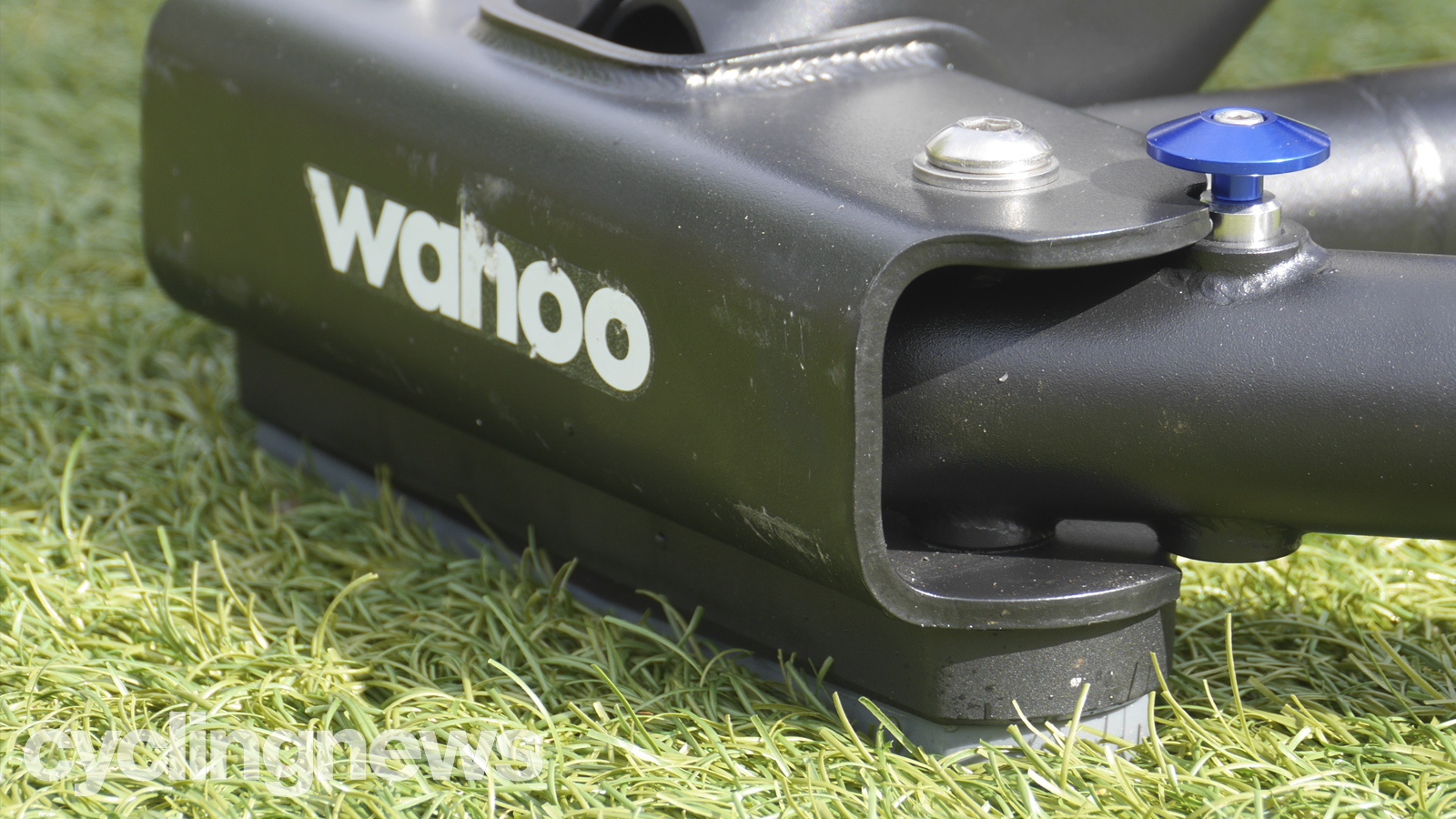
With the Axis feet, you actually get three pairs, each with progressing levels of cushioning, which fit to the two fold-out legs, while a cushioned rubber foot sits on the central leg and beneath the base of the unit. According to Wahoo, this offers up to five degrees of left-right roll, and the pair you should use depends on your weight.
They perform the same height-adjustable duties as the previous model's standard feet, and they are available to buy on their own (at £64.99 / $79.99 / AU$129.95), so anyone using a previous Kickr can add this functionality without buying the latest trainer.
In reality, they offer around the same amount of float as the interlocking foam flooring tiles in my garage (that cost much less) and I can envisage a proper turbo trainer mat providing similar results.
I wouldn't recommend these as an aftermarket upgrade to an old Kickr, but they're a nice addition, especially since Wahoo didn't increase the price with the V5. I can imagine they will prove enticing to anyone with hard flooring or anyone riding in an apartment with downstairs neighbours.
As for the RJ25 port. Wahoo has since launched the DirectConnect, a £79.99 / $99.99 / AU$139.95 adaptor that allows you to connect an ethernet cable to your Kickr, meaning you can plug your Kickr into your router or directly into your laptop so that you're not relying on wireless connectivity. This isn't something I've been able to put to the test for various logistical reasons, but on the assumption that it works as advertised, it could well be a game-changer, for reasons I'll explain later.
Specifications
As mentioned, one of the upgrades that came with the Kickr V5 is an improvement in power accuracy, which is now down to within +/- 1%. That aside, all of the other key comparables remain the same as the 2018 model.
What that means is the Kickr V5 can provide 2,200 watts of resistance at a speed of 40km/h. Of course, this is more than you're ever likely to need, but it's in line with similarly priced competitors, with the Saris H3 sitting at 2,000 watts, the Tacx Neo 2T at 2,200, and the Elite Direto XR at 2,300. If this were a game of Turbo Trainer Top Trumps, the Neo 2T would win the simulated gradient category with its 25-per cent maximum, while the Kickr V5 tops out at 20 - again, steeper than anyone is likely to need, bar any extremely specific use cases.
One area where the Kickr excels is in the new zero-calibration algorithm, which basically means it has an automatic spin-down function (or auto-calibration). In practice, what this means is that you can jump on the bike and go, without that short-but-annoying need to spin-down your trainer before you start.
According to Wahoo, the way this works is: "We're continuously monitoring the Kickr and detecting coasting. When the Kickr coasts we are able to measure the drag in the system which allows us to recalibrate." Unlike the Kickr Bike, you can still run the spin-down command, however, while it will accept the new zero value, it will quickly discard it and self-adjust.
As with the previous Kickr, the manual spin-down can be performed in the Wahoo Fitness app, along with settings and the initial setup. The setup has a step-by-step walkthrough that makes it super simple, and after you've done it once, your Kickr will automatically connect as soon as you open the app when in Bluetooth range. The Kickr can connect to three simultaneous Bluetooth connections (a feature introduced on the Kickr V4), so you don't need to disconnect it from other devices before you're able to access the settings.
Once connected, you can perform basic commands like updating firmware, adjusting wheel circumference, and connecting it to your Kickr Climb, if you have one.
There's also a setting to 'smooth' your power readings, which doesn't actually change the responsiveness of the trainer or the resistance while riding, but when shown on power graphs in your chosen indoor cycling apps, it makes for a cleaner aesthetic. It also helps to negate power dropouts. With that in mind, if you're someone with enormous one-second peak power and you want to use it in a Zwift race to open up a gap in the field, you probably want to leave it switched off, however, if you suffer occasional short power drops, it can help to smooth over those.
The Kickr does miss out on a few of the trick features that others boast, such as simulated vibration found on the Tacx Neo 2T, electromagnetic resistance found in the Kickr Bike and Wattbike, an inbuilt motor to simulate downhills better, and the ability to use it without electricity.
Data accuracy
Throughout the majority of testing, I paired the Kickr V5 with the Specialized Dura-Ace power meter that comes stock on the S-Works Tarmac SL7, I've dual-recorded almost every ride and found good levels of consistency across both devices. To quantify this, here are a couple of TrainerRoad workouts from this week.
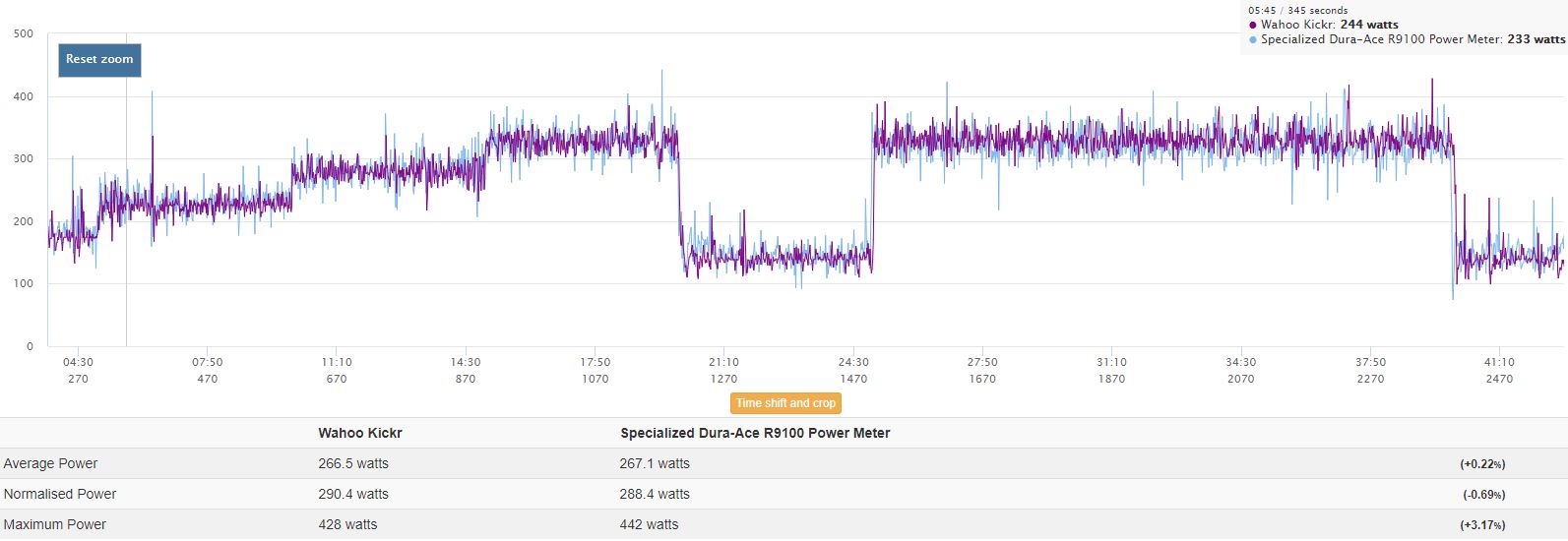
In the first, you can see the power tracks in almost perfect harmony, with an average power variance of just 0.22%.

In the second - a 'Microbursts' workout consisting of 15 seconds at 150 per cent of FTP followed by 15 seconds at 40 per cent. For an unknown reason, the Kickr is reading slightly higher at these peaks, causing an average difference of 3.7 per cent. However, the reason for using this specific workout was to test responsiveness of the Kickr throughout changes in resistance. As you can see, it is perfectly in sync with the power meter.
- Indoor cycling training plan: smash your summer riding goals with this eight-week indoor training plan
While performing the workout above, I also paid attention to how quickly the Kickr responded to resistance changes in the app. I chose the highly fluctuating microburst workout so that the resistance change was substantial and repeating, and throughout, the resistance change was immediately noticeable at the pedals; as soon as the 'on' section of the workout began, that's when the resistance changed.
However, an effort at 150 per cent of FTP is quite uncontrolled when it comes to pedalling smoothness and it doesn't make for the best visual representation of the Kickr's responsiveness, so for that, we're going to look at a workout that switches from 50 to 106 per cent of FTP - TrainerRoad's 'North Schell'.

As you can see at 29:00, the change in my power output is immediate as the resistance kicks in and I begin increasing my power. I pushed through the initial resistance change which caused a spike over target at 29:02, and it settled after just four seconds.

In the opposite direction, the power drop was almost instant. I was slightly broken from the effort, but despite a drop in cadence (the slightly curved white line), it settled me back against the workout's requirement after just seven seconds.
Smaller resistance changes are faster still, meaning for constant efforts, there is no fishtailing above and below the required resistance.
Auto-calibration
The new auto-calibration is a really useful addition that really saves hassle and instils a sense of confidence in the numbers put out during a race or ride.
Despite the spin-down's inherent simplicity, it's all too easy to forget to do, and then when you eventually remember, you probably won't want to interrupt your Zwift workout, even less if you're halfway through a race. However, the knowledge that you're riding an uncalibrated turbo trainer will very quickly get into your head when you start to struggle.
"It's not me, the turbo's under-reading," at least you have an excuse when you get dropped.
What's more, you could perform a spin-down pre-race only for the temperature and humidity in the room rise throughout a hard workout and skew the numbers for the latter part of the ride. You can hardly stop halfway through a ZRL race and calibrate your Kickr, so it's nice to know that concern is gone.
However, despite auto-calibration being my favourite thing about the new Kickr, there is one flaw. As it works by measuring drag when coasting, it renders itself useless if you're following a set workout where no coasting exists - which is most of them.
This is best highlighted by a four-hour endurance ride I performed back in January.

As you can see above, for the first hour of the ride, the variance between the Kickr and the Specialized Dura-Ace power meter is just 1.11 per cent.

However, for this cropped section later in the ride, the variance is much higher at 6.46 per cent.

The reason I've not chosen the final hour in that ride is because, as shown in the image above, the data became much more erratic across both devices for the final 30 minutes. Possibly a symptom of tired legs, but also possibly a Bluetooth interference problem, which leads me onto another occasional issue of erratic readings, as shown in the following ride.

The first hour of this three-hour TrainerRoad endurance ride was particularly erratic. With power smoothing turned on, the power graph should create a smooth and consistent line (as shown by the purple line in the second hour).
These mini-dropouts were enough to drop the average power of the first hour by around seven per cent.
As you can see from the gap in the blue line at around 30-minutes, I stopped pedalling in hope that some coasting would mean auto-calibration and be enough to sort it out. No luck. The second gap at 1h 10m is the point that I stopped the ride to unplug the Kickr, which, as you can see from the subsequent smoothness of the purple line, was enough to solve the problem - although it did return later.
This issue only arises very occasionally, around once a month at most, and it's an easy fix, but it's a frustrating one nonetheless. I'm unsure if it's even an issue with the Kickr itself as I've been unable to replicate it consistently.
I've chalked it up to Bluetooth interference, and it's for this very reason that even without using the DirectConnect, I am convinced it is a good thing.
Verdict
The Wahoo Kickr V5 might not win the game of Turbo Trainer Top Trumps when it comes to maximum resistance and simulated incline, nor does it have some of the bells and whistles that others can boast, but in the areas that matter, Wahoo has created a quite brilliant indoor cycling companion.
By improving the data accuracy to within one per cent, adding a zero-calibration algorithm and adding a little bit of comfort enhancement to the feet, the latest Wahoo Kickr takes what was already one of the best turbo trainers and makes it even more complete.
Aside from a few Bluetooth interference issues, the Kickr has remained consistent and faultless throughout this test period, and with the new DirectConnect function, this problem is all but null and void. In the absence of any of its competitors solving this problem, the Wahoo Kickr is my pick as today's market-leading turbo trainer.
Tech spec: Wahoo Kickr V5
- Price: USD $1,199.99 / GBP £999.99 / EURO €1,199.99 / CAD $1,799.99 / AUD $1,799.95
- Max Resistance: 2,200 watts
- Max Incline: 20%
- Power accuracy: +/- 1%

Josh is Associate Editor of Cyclingnews – leading our content on the best bikes, kit and the latest breaking tech stories from the pro peloton. He has been with us since the summer of 2019 and throughout that time he's covered everything from buyer's guides and deals to the latest tech news and reviews.
On the bike, Josh has been riding and racing for over 15 years. He started out racing cross country in his teens back when 26-inch wheels and triple chainsets were still mainstream, but he found favour in road racing in his early 20s, racing at a local and national level for Somerset-based Team Tor 2000. These days he rides indoors for convenience and fitness, and outdoors for fun on road, gravel, 'cross and cross-country bikes, the latter usually with his two dogs in tow.
